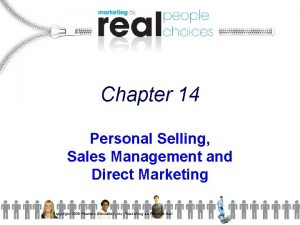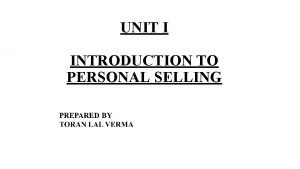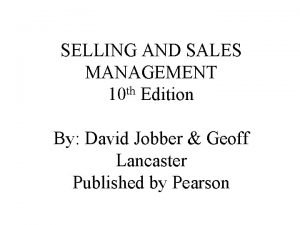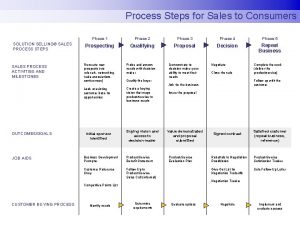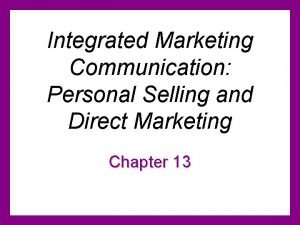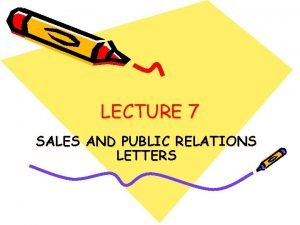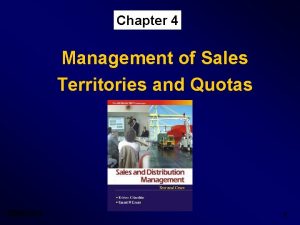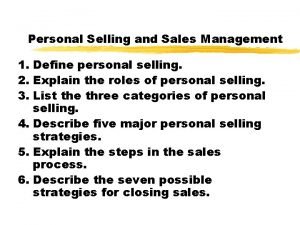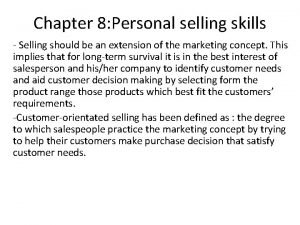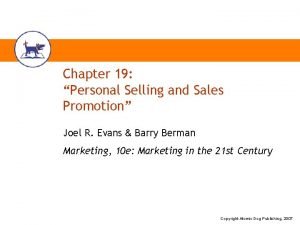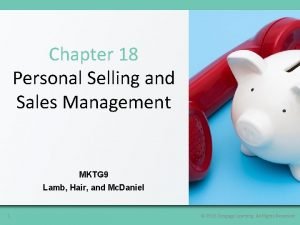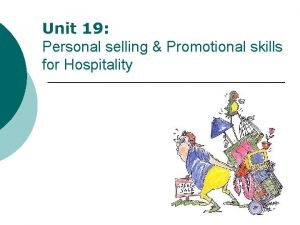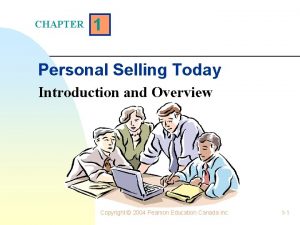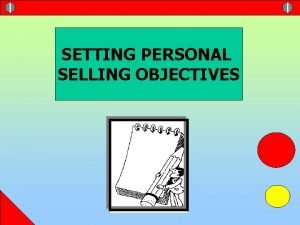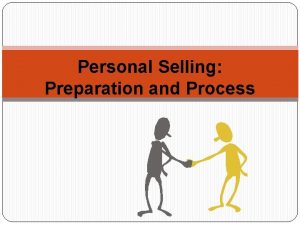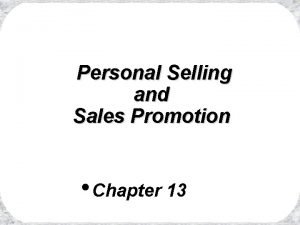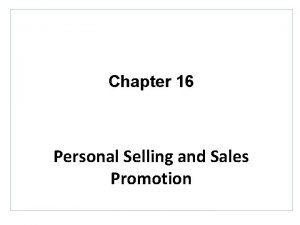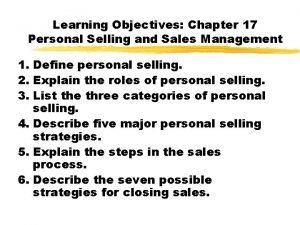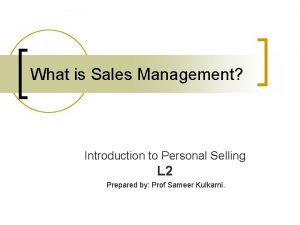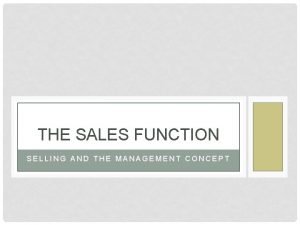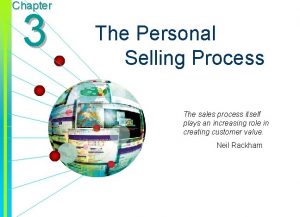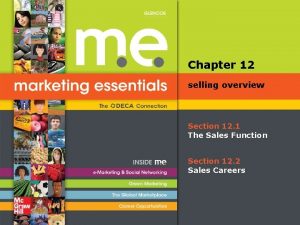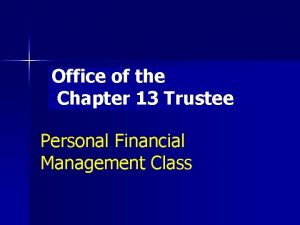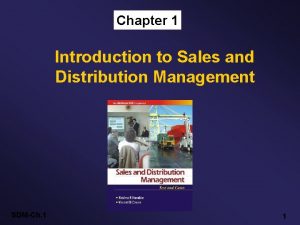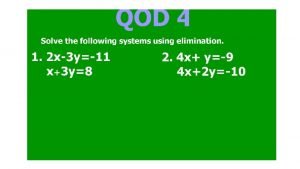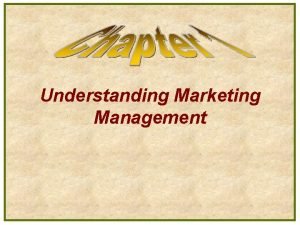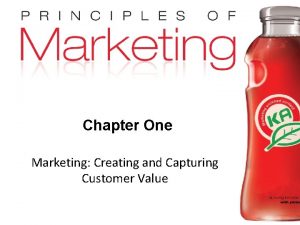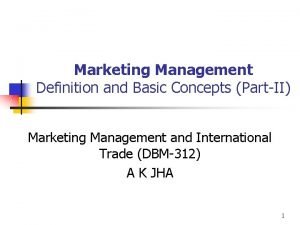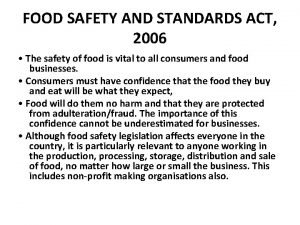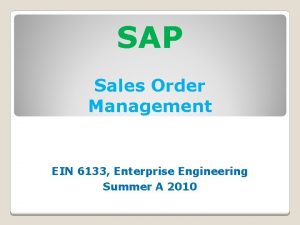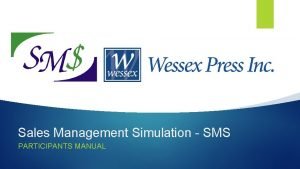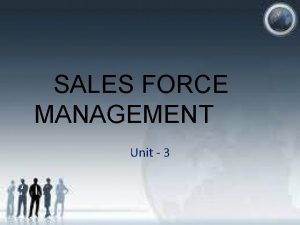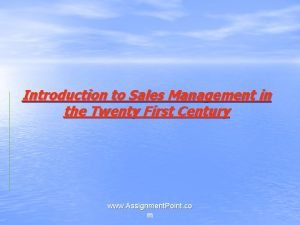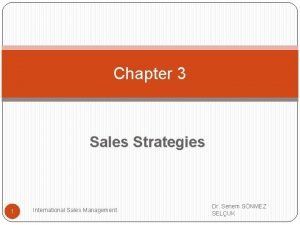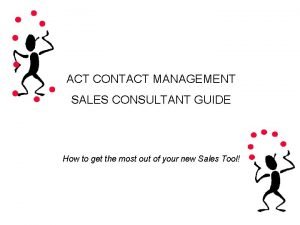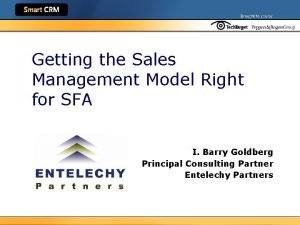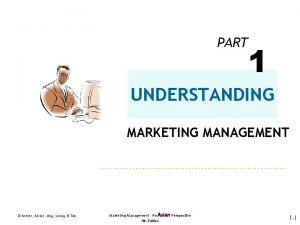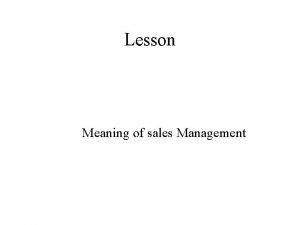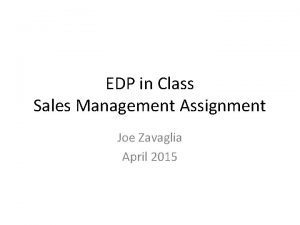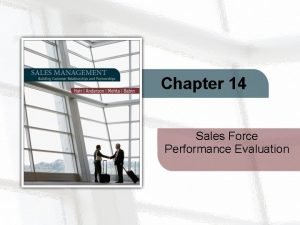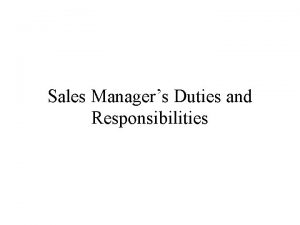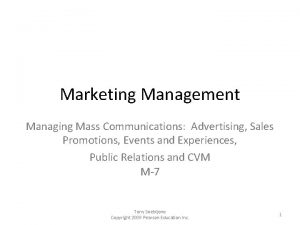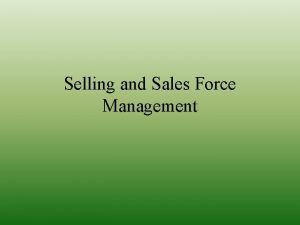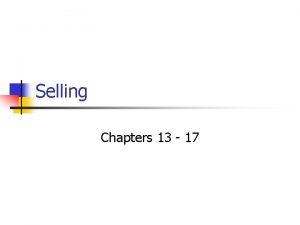CHAPTER PERSONAL SELLING AND SALES MANAGEMENT 2006 Mc




















































































- Slides: 84

CHAPTER PERSONAL SELLING AND SALES MANAGEMENT © 2006 Mc. Graw-Hill Companies, Inc. , Mc. Graw-Hill/Irwin Slide 20 -2

AFTER READING THIS CHAPTER YOU SHOULD BE ABLE TO: 1. Discuss the nature and scope of personal selling and sales management in marketing. 2. Identify the different types of personal selling. 3. Explain the stages in the personal selling process. © 2006 Mc. Graw-Hill Companies, Inc. , Mc. Graw-Hill/Irwin Slide 20 -3

AFTER READING THIS CHAPTER YOU SHOULD BE ABLE TO: 4. Describe the major functions of sales management. © 2006 Mc. Graw-Hill Companies, Inc. , Mc. Graw-Hill/Irwin Slide 20 -4

SCOPE AND SIGNIFICANCE OF PERSONAL SELLING AND SALES MANAGEMENT • Nature of Personal Selling and Sales Management – Personal Selling – two-way flow of communication between buyer and seller, often in a face-to-face encounter, designed to influence a person’s of group’s purchase decision • Also occurs by telephone , through video teleconferencing, and the internet between buyers and sellers © 2006 Mc. Graw-Hill Companies, Inc. , Mc. Graw-Hill/Irwin Slide 20 -6

SCOPE AND SIGNIFICANCE OF PERSONAL SELLING AND SALES MANAGEMENT • Nature of Personal Selling and Sales Management – planning the selling program and implementing and controlling the personal selling effort of the firm • Tasks involved include: setting objectives; organizing the sales force; recruiting, selecting, training, and compensating salespeople; and evaluating performance of individual salespeople © 2006 Mc. Graw-Hill Companies, Inc. , Mc. Graw-Hill/Irwin Slide 20 -6

SCOPE AND SIGNIFICANCE OF PERSONAL SELLING AND SALES MANAGEMENT • Selling Happens Almost Everywhere – “Everyone lives by selling something” © 2006 Mc. Graw-Hill Companies, Inc. , Mc. Graw-Hill/Irwin Slide 20 -6

FIGURE 20 -1 Personal selling and sales management quiz 1. 20% 3. False 2. $350 4. 60% © 2006 Mc. Graw-Hill Companies, Inc. , Mc. Graw-Hill/Irwin Slide 20 -7

SCOPE AND SIGNIFICANCE OF PERSONAL SELLING AND SALES MANAGEMENT • Personal Selling in Marketing • Creating Customer Value Through Salespeople: Relationship and Partnership Selling § Relationship Selling – long-term § Partnership Selling (or Enterprise Selling) © 2006 Mc. Graw-Hill Companies, Inc. , Mc. Graw-Hill/Irwin Slide 20 -8

FIGURE 20 -A How salespeople create value for customers © 2006 Mc. Graw-Hill Companies, Inc. , Mc. Graw-Hill/Irwin Slide 20 -9

Salesperson in the Operating Room Why does Medtronic do this? © 2006 Mc. Graw-Hill Companies, Inc. , Mc. Graw-Hill/Irwin Slide 20 -10

Concept Check 1. What is personal selling? A: Personal selling involves the twoway flow of communication between a buyer and seller, often in a face-toface encounter, designed to influence a person’s or group’s purchase decision. © 2006 Mc. Graw-Hill Companies, Inc. , Mc. Graw-Hill/Irwin Slide 20 -11

Concept Check 2. What is involved in sales management? A: Sales management involves planning the selling program and implementing and controlling the personal selling effort of the firm. © 2006 Mc. Graw-Hill Companies, Inc. , Mc. Graw-Hill/Irwin Slide 20 -12

THE MANY FORMS OF PERSONAL SELLING • Order Taking § Outside Order Takers § Inside Order Takers, Order Clerks, or Salesclerks § Inbound Telemarketing • Order Getting § Outbound Telemarketing © 2006 Mc. Graw-Hill Companies, Inc. , Mc. Graw-Hill/Irwin Slide 20 -13

FIGURE 20 -B Comparing order takers with order getters © 2006 Mc. Graw-Hill Companies, Inc. , Mc. Graw-Hill/Irwin Slide 20 -14

FIGURE 20 -2 How outside order-getting salespeople spend their time each week © 2006 Mc. Graw-Hill Companies, Inc. , Mc. Graw-Hill/Irwin Slide 20 -16

THE MANY FORMS OF PERSONAL SELLING • Customer Sales Support Personnel § Missionary Salespeople – promotion and introduction § Sales Engineer – identifying, analyzing & solving § Team Selling – team of professionals (cross-functional) § Conference Selling – discuss problems and opportunities § Seminar Selling – conducts educational program for technical staff © 2006 Mc. Graw-Hill Companies, Inc. , Mc. Graw-Hill/Irwin Slide 20 -17

MARKETING NEWSNET Creating and Sustaining Customer Value through Cross-Functional Team Selling © 2006 Mc. Graw-Hill Companies, Inc. , Mc. Graw-Hill/Irwin Slide 20 -18

Concept Check 1. What is the principal difference between an order taker and an order getter? A: An order taker processes routine orders or reorders for products that were already sold by the company. An order getter sells in a conventional sense and identifies prospective customers, provides customers with information, persuades customers to buy, closes sales, and follows up on their use of a product or service. © 2006 Mc. Graw-Hill Companies, Inc. , Mc. Graw-Hill/Irwin Slide 20 -19

Concept Check 2. What is team selling? A: Team selling uses an entire team of professionals in selling to and servicing major customers. © 2006 Mc. Graw-Hill Companies, Inc. , Mc. Graw-Hill/Irwin Slide 20 -20

THE PERSONAL SELLING PROCESS: BUILDING RELATIONSHIPS • Personal Selling Process – six stages: 1. 2. 3. 4. 5. 6. Prospecting Preapproach Approach Presentation Close Follow-up © 2006 Mc. Graw-Hill Companies, Inc. , Mc. Graw-Hill/Irwin Slide 20 -21

FIGURE 20 -C Stages in the personal selling process © 2006 Mc. Graw-Hill Companies, Inc. , Mc. Graw-Hill/Irwin Slide 20 -23

FIGURE 20 -3 Stages and objectives of the personal selling process © 2006 Mc. Graw-Hill Companies, Inc. , Mc. Graw-Hill/Irwin Slide 20 -22

THE PERSONAL SELLING PROCESS: BUILDING RELATIONSHIPS • Prospecting – search for and qualification of potential customers § Lead – name who may be possible customer § Prospect – customer who wants or needs product § Qualified Prospect – want, money, and authority to buy § Cold Canvassing © 2006 Mc. Graw-Hill Companies, Inc. , Mc. Graw-Hill/Irwin Slide 20 -21

THE PERSONAL SELLING PROCESS: BUILDING RELATIONSHIPS • Preapproach – obtaining further information about prospect and deciding best method of approach • Approach – initial meeting between salesperson and prospect © 2006 Mc. Graw-Hill Companies, Inc. , Mc. Graw-Hill/Irwin Slide 20 -25

An American Salesperson and Japanese Customer In the approach stage, what issues to address? © 2006 Mc. Graw-Hill Companies, Inc. , Mc. Graw-Hill/Irwin Slide 20 -26

THE PERSONAL SELLING PROCESS: BUILDING RELATIONSHIPS • Presentation § Stimulus-Response Format • Stimulus-Response Presentation • Suggestive Selling § Formula Selling Format • Formula Selling Presentation • Canned Selling Presentation © 2006 Mc. Graw-Hill Companies, Inc. , Mc. Graw-Hill/Irwin Slide 20 -27

SALES PRESENTATION METHODS – SELECT ONE CAREFULLY • The four sales presentation methods are: – Memorized – Formula – Need-satisfaction – Problem-solution • The basic difference between the four methods is the percentage of the conversation controlled by the salesperson. © 2006 Mc. Graw-Hill Companies, Inc. , Mc. Graw-Hill/Irwin

SALES PRESENTATION METHODS – SELECT ONE CAREFULLY • Four Sales Presentation Methods 1. The Memorized Sales Presentation (canned) • Salesperson’s role is to develop initial stimulus into an affirmative response to an eventual purchase request. 2. The Formula Presentation (persuasive selling) • The salesperson follows a less structured, general outline in making a presentation, allowing more flexibility and less direction (AIDA). Controls conversation during sales talk; especially at the beginning. © 2006 Mc. Graw-Hill Companies, Inc. , Mc. Graw-Hill/Irwin

SALES PRESENTATION METHODS – SELECT ONE CAREFULLY 3. The Need-Satisfaction Presentation • Designed as a flexible, interactive sales presentation, yet the most challenging and creative form of selling • Need-development phase • Need-awareness phase • Need-fulfillment phase © 2006 Mc. Graw-Hill Companies, Inc. , Mc. Graw-Hill/Irwin

SALES PRESENTATION METHODS – SELECT ONE CAREFULLY 4. The Problem-Solution Presentation • Selling highly complex or technical products • It may take several sales calls to develop a detailed analysis • A flexible, customized approach to involving an in-depth study of a prospect’s needs © 2006 Mc. Graw-Hill Companies, Inc. , Mc. Graw-Hill/Irwin

A Salesperson and Customer What type of presentation format and why use it? © 2006 Mc. Graw-Hill Companies, Inc. , Mc. Graw-Hill/Irwin Slide 20 -29

THE PERSONAL SELLING PROCESS: BUILDING RELATIONSHIPS • Presentation § Handling Objections • Acknowledge and Convert the Objection • Postpone • Agree and Neutralize • Accept the Objection • Ignore the Objection Slide 20 -30 © 2006 Mc. Graw-Hill Companies, Inc. , Mc. Graw-Hill/Irwin

THE PERSONAL SELLING PROCESS: BUILDING RELATIONSHIPS • Close – obtaining purchase commitment § Trial Close § Assumptive Close § Urgency Close § Final Close • Follow-Up © 2006 Mc. Graw-Hill Companies, Inc. , Mc. Graw-Hill/Irwin Slide 20 -32

Concept Check 1. What are the six stages in the personal selling process? A: The six stages in the personal selling process are: (1) prospecting, (2) preapproach, (3) approach, (4) presentation, (5) close, and (6) follow-up. © 2006 Mc. Graw-Hill Companies, Inc. , Mc. Graw-Hill/Irwin Slide 20 -34

Concept Check 2. What is the distinction between a lead and a qualified prospect? A: A lead is the name of a person who may be a possible customer whereas a qualified prospect is an individual wants the product, can afford to buy it, and is the decision maker. © 2006 Mc. Graw-Hill Companies, Inc. , Mc. Graw-Hill/Irwin Slide 20 -35

Concept Check 3. Which presentation format is most consistent with the marketing concept? Why? A: The need-satisfaction presentation format probing and listening by the salesperson to identify needs and interests of prospective buyers and then tailors the presentation to the prospect and highlights product benefits, consistent with the marketing concept. © 2006 Mc. Graw-Hill Companies, Inc. , Mc. Graw-Hill/Irwin Slide 20 -36

FIGURE 20 -4 The sales management process © 2006 Mc. Graw-Hill Companies, Inc. , Mc. Graw-Hill/Irwin Slide 20 -38

THE SALES MANAGEMENT PROCESS • Sales Plan Formulation: Setting Direction – Sales Plan – Statement describing what is to be achieved and where and how the selling effort of salespeople is to be employed – Setting Objectives – specifies what is to be achieved for the total sales force and each salesperson © 2006 Mc. Graw-Hill Companies, Inc. , Mc. Graw-Hill/Irwin Slide 20 -37

ETHICS AND SOCIAL RESPONSIBILITY ALERT The Ethics of Asking Customers About Competitors © 2006 Mc. Graw-Hill Companies, Inc. , Mc. Graw-Hill/Irwin Slide 20 -39

THE SALES MANAGEMENT PROCESS • Sales Plan Formulation: Setting Objectives – Output-related – focuses on dollar or unit sales volume, number of new customers, and profit – Input-related – emphasizes the number of sales calls and selling expenses – Behaviorally-related – focuses on product knowledge, customer service, and selling and communication skills © 2006 Mc. Graw-Hill Companies, Inc. , Mc. Graw-Hill/Irwin Slide 20 -37

THE SALES MANAGEMENT PROCESS • Sales Plan Formulation: Setting Objectives – Firms emphasize knowledge of competition as an objective – Objectives should be precise and measurable and specify time period over which they are achieved – Objectives should serve as performance standards for the evaluation of the sales force © 2006 Mc. Graw-Hill Companies, Inc. , Mc. Graw-Hill/Irwin Slide 20 -37

THE SALES MANAGEMENT PROCESS • Sales Plan Formulation: Organizing the Sales Force § Own Sales Force vs. Independent Agents § Organized according to: • Geography – simplest: regions, districts, territories • Customer Type – different buyers have different needs. Variation: Major Account Management • Product/Service – specific knowledge required © 2006 Mc. Graw-Hill Companies, Inc. , Mc. Graw-Hill/Irwin Slide 20 -37

FIGURE 20 -6 Organizing the salesforce by customer, product, and geography © 2006 Mc. Graw-Hill Companies, Inc. , Mc. Graw-Hill/Irwin Slide 20 -43

FIGURE 20 -6 A Organizing the salesforce by geography © 2006 Mc. Graw-Hill Companies, Inc. , Mc. Graw-Hill/Irwin Slide 20 -44

FIGURE 20 -6 B Organizing the salesforce by customer © 2006 Mc. Graw-Hill Companies, Inc. , Mc. Graw-Hill/Irwin Slide 20 -45

FIGURE 20 -6 C Organizing the salesforce by product © 2006 Mc. Graw-Hill Companies, Inc. , Mc. Graw-Hill/Irwin Slide 20 -46

THE SALES MANAGEMENT PROCESS • Sales Plan Formulation: Setting Direction § Organizing the Salesforce—Size • Workload Method • Developing Account Management Policies © 2006 Mc. Graw-Hill Companies, Inc. , Mc. Graw-Hill/Irwin Slide 20 -47

FIGURE 20 -7 Account management policy grid grouping customers according to the level of opportunity and a firm’s competitive sales position © 2006 Mc. Graw-Hill Companies, Inc. , Mc. Graw-Hill/Irwin Slide 20 -48

FIGURE 20 -4 The sales management process © 2006 Mc. Graw-Hill Companies, Inc. , Mc. Graw-Hill/Irwin Slide 20 -38

THE SALES MANAGEMENT PROCESS • Sales Plan Implementation: Putting the Plan into Action § Salesforce Recruitment and Selection • Job Analysis • Job Description • Emotional Intelligence § Salesforce Training © 2006 Mc. Graw-Hill Companies, Inc. , Mc. Graw-Hill/Irwin Slide 20 -49

FIGURE 20 -8 U. S. sales force composition and change © 2006 Mc. Graw-Hill Companies, Inc. , Mc. Graw-Hill/Irwin Slide 20 -51

FIGURE 20 -8 A U. S. sales force composition and change © 2006 Mc. Graw-Hill Companies, Inc. , Mc. Graw-Hill/Irwin Slide 20 -52

FIGURE 20 -8 B U. S. sales force composition and change © 2006 Mc. Graw-Hill Companies, Inc. , Mc. Graw-Hill/Irwin Slide 20 -53

FIGURE 20 -8 C U. S. sales force composition and change © 2006 Mc. Graw-Hill Companies, Inc. , Mc. Graw-Hill/Irwin Slide 20 -54

THE SALES MANAGEMENT PROCESS • Sales Plan Implementation: Putting the Plan into Action § Salesforce Motivation and Compensation • Straight Salary Compensation Plan • Straight Commission Compensation Plan • Combination Compensation Plan © 2006 Mc. Graw-Hill Companies, Inc. , Mc. Graw-Hill/Irwin Slide 20 -55

Mary Kay Cosmetics Annual Sales Meeting Why use nonmonetary compensation? © 2006 Mc. Graw-Hill Companies, Inc. , Mc. Graw-Hill/Irwin Slide 20 -56

FIGURE 20 -4 The sales management process © 2006 Mc. Graw-Hill Companies, Inc. , Mc. Graw-Hill/Irwin Slide 20 -38

THE SALES MANAGEMENT PROCESS • Salesforce Evaluation and Control: Measuring Results § Quantitative Assessments • Sales Quota § Behavioral Evaluation © 2006 Mc. Graw-Hill Companies, Inc. , Mc. Graw-Hill/Irwin Slide 20 -57

THE SALES MANAGEMENT PROCESS • Salesforce Automation and Customer Relationship Management § Salesforce Automation (SFA) § Salesforce Computerization § Salesforce Communication © 2006 Mc. Graw-Hill Companies, Inc. , Mc. Graw-Hill/Irwin Slide 20 -58

Concept Check 1. What are three types of selling objectives? A: They are: (1) output-related (dollars or unit sales, new customers, profit); (2) input-related (sales calls, selling expenses); and (3) behavioral-related (product knowledge, customer service, selling and communication skills). © 2006 Mc. Graw-Hill Companies, Inc. , Mc. Graw-Hill/Irwin Slide 20 -61

Concept Check 2. What three factors are used to structure sales organizations? A: geography, customer, and product or service © 2006 Mc. Graw-Hill Companies, Inc. , Mc. Graw-Hill/Irwin Slide 20 -62

Concept Check 3. How does emotional intelligence tie to adaptive selling? A: Emotional intelligence is the ability to understand one’s own emotions and the emotions of people with whom one interacts on a daily basis, qualities that are important for adaptive selling. © 2006 Mc. Graw-Hill Companies, Inc. , Mc. Graw-Hill/Irwin Slide 20 -63

Personal Selling Personal selling involves the two-way flow of communication between a buyer and seller, designed to influence a person’s or group’s purchase decision, usually in face-to-face communication between the sender and receiver. © 2006 Mc. Graw-Hill Companies, Inc. , Mc. Graw-Hill/Irwin Slide 20 -82

Sales Management Sales management involves planning the selling program and implementing and controlling the personal selling effort of the firm. © 2006 Mc. Graw-Hill Companies, Inc. , Mc. Graw-Hill/Irwin Slide 20 -83

Relationship Selling Relationship selling is the practice of building ties to customers based on a salesperson’s attention and commitment to customer needs over time. © 2006 Mc. Graw-Hill Companies, Inc. , Mc. Graw-Hill/Irwin Slide 20 -84

Partnership Selling Partnership selling is the practice whereby buyers and sellers combine their expertise and resources to create customized solutions, commit to joint planning, and share customer, competitive, and company information for their mutual benefit, and ultimately the customer. Also called enterprise selling. © 2006 Mc. Graw-Hill Companies, Inc. , Mc. Graw-Hill/Irwin Slide 20 -85

Order Taker An order taker processes routine orders or reorders for products that were already sold by the company. © 2006 Mc. Graw-Hill Companies, Inc. , Mc. Graw-Hill/Irwin Slide 20 -86

Order Getter An order getter sells in a conventional sense and identifies prospective customers, provides customers with information, persuades customers to buy, closes sales, and follows up on customers’ use of a product or service. © 2006 Mc. Graw-Hill Companies, Inc. , Mc. Graw-Hill/Irwin Slide 20 -87

Missionary Salespeople Missionary salespeople are sales support personnel who do not directly solicit orders but rather concentrate on performing promotional activities and introducing new products. © 2006 Mc. Graw-Hill Companies, Inc. , Mc. Graw-Hill/Irwin Slide 20 -88

Sales Engineer A sales engineer is a salesperson who specializes in identifying, analyzing, and solving customer problems and brings know-how and technical expertise to the selling situation but often does not actually sell products and services. © 2006 Mc. Graw-Hill Companies, Inc. , Mc. Graw-Hill/Irwin Slide 20 -89

Team Selling Team selling is the practice of using an entire team of professionals in selling to and servicing major customers. © 2006 Mc. Graw-Hill Companies, Inc. , Mc. Graw-Hill/Irwin Slide 20 -90

Personal Selling Process The personal selling process consists of sales activities occurring before and after the sale itself, consisting of six stages: (1) prospecting, (2) preapproach, (3) approach, (4) presentation, (5) close, and (6) follow-up. © 2006 Mc. Graw-Hill Companies, Inc. , Mc. Graw-Hill/Irwin Slide 20 -91

Stimulus-Response Presentation Stimulus-response presentation is a presentation format which assumes that given the appropriate stimulus by a salesperson, the prospect will buy. © 2006 Mc. Graw-Hill Companies, Inc. , Mc. Graw-Hill/Irwin Slide 20 -92

Formula Selling Presentation Formula selling presentation is a presentation format that consists of information that must be provided in an accurate, thorough, and step-by-step manner to inform the prospect. © 2006 Mc. Graw-Hill Companies, Inc. , Mc. Graw-Hill/Irwin Slide 20 -93

Need-Satisfaction Presentation Need-satisfaction presentation is a presentation format that emphasizes probing and listening by the salesperson to identify needs and interests of prospective buyers. © 2006 Mc. Graw-Hill Companies, Inc. , Mc. Graw-Hill/Irwin Slide 20 -94

Adaptive Selling Adaptive selling is a need-satisfaction presentation format that involves adjusting the presentation to fit the selling situation, such as knowing when to offer solutions and when to ask for more information. © 2006 Mc. Graw-Hill Companies, Inc. , Mc. Graw-Hill/Irwin Slide 20 -95

Consultative Selling Consultative selling is a need-satisfaction presentation format that focuses on problem identification, where the salesperson serves as an expert on problem recognition and resolution. © 2006 Mc. Graw-Hill Companies, Inc. , Mc. Graw-Hill/Irwin Slide 20 -96

Sales Plan A sales plan is a statement describing what is to be achieved and where and how the selling effort of salespeople is to be deployed. © 2006 Mc. Graw-Hill Companies, Inc. , Mc. Graw-Hill/Irwin Slide 20 -97

Major Account Management Major account management is the practice of using team selling to focus on important customers so as to build mutually beneficial, long-term, cooperative relationships. Also called key account management. © 2006 Mc. Graw-Hill Companies, Inc. , Mc. Graw-Hill/Irwin Slide 20 -98

Workload Method The workload method is a formula-based method for determining the size of a salesforce that integrates the number of customers served, call frequency, call length, and available selling time to arrive at a figure for the salesforce size. © 2006 Mc. Graw-Hill Companies, Inc. , Mc. Graw-Hill/Irwin Slide 20 -99

Account Management Polices Account management policies specify whom salespeople should contact, what kinds of selling and customer service activities should be engaged in, and how these activities should be carried out. © 2006 Mc. Graw-Hill Companies, Inc. , Mc. Graw-Hill/Irwin Slide 20 -100

Emotional Intelligence Emotional intelligence is the ability to understand one’s own emotions and the emotions of people with whom one interacts on a daily basis. © 2006 Mc. Graw-Hill Companies, Inc. , Mc. Graw-Hill/Irwin Slide 20 -101

Sales Quota A sales quota contains specific goals assigned to a salesperson, sales team, branch sales office, or sales district for a stated time period. © 2006 Mc. Graw-Hill Companies, Inc. , Mc. Graw-Hill/Irwin Slide 20 -102

Salesforce Automation Salesforce automation (SFA) is the use of computer, information, communication, and Internet technologies to make the sales function more effective and efficient. © 2006 Mc. Graw-Hill Companies, Inc. , Mc. Graw-Hill/Irwin Slide 20 -103
 Contoh sales management
Contoh sales management Personal selling process in sales management
Personal selling process in sales management Inside order takers
Inside order takers Selling and sales management
Selling and sales management Missionary selling
Missionary selling Solution sales process steps
Solution sales process steps Personal selling and public relations
Personal selling and public relations Personal selling vs direct marketing
Personal selling vs direct marketing Personal selling advantages
Personal selling advantages Sales organization structure
Sales organization structure Discuss the nuances of sales letters.
Discuss the nuances of sales letters. Sales deployment
Sales deployment Procedure for designing sales territories
Procedure for designing sales territories 7 steps sales process
7 steps sales process Definition of personal selling
Definition of personal selling Personal selling channels
Personal selling channels Personal selling skills
Personal selling skills Personal selling plan
Personal selling plan What is the final step of the selling process?
What is the final step of the selling process? Promotional skills
Promotional skills Bentuk personal selling
Bentuk personal selling Direct marketing vs personal selling
Direct marketing vs personal selling The development of a personal selling philosophy involves
The development of a personal selling philosophy involves Objectives of personal selling
Objectives of personal selling Personal selling nike
Personal selling nike Personal selling skills
Personal selling skills Personal selling activities
Personal selling activities Sales force promotions
Sales force promotions Personal selling
Personal selling Personal selling
Personal selling Personal selling
Personal selling Personal selling philosophy example
Personal selling philosophy example Philosophy of selling
Philosophy of selling Functions of personal selling
Functions of personal selling Introduction of personal selling
Introduction of personal selling Functions of personal selling
Functions of personal selling Sales force composite
Sales force composite Personal sales process
Personal sales process Chapter 12 selling overview
Chapter 12 selling overview Chapter 13 personal financial management course
Chapter 13 personal financial management course Importance of sales and distribution management
Importance of sales and distribution management Advertising management and sales promotion
Advertising management and sales promotion How to audit revenue
How to audit revenue Chapter 9 auditing sales and receivables
Chapter 9 auditing sales and receivables Formas no verbales del gerundio
Formas no verbales del gerundio Higiene personal
Higiene personal Magbigay ng iyong personal na pahayag ng misyon mo sa buhay
Magbigay ng iyong personal na pahayag ng misyon mo sa buhay Anggaran beban penjualan dan administrasi
Anggaran beban penjualan dan administrasi Buying and selling of securities
Buying and selling of securities What is marketing management
What is marketing management Write inequalities to describe the region 3
Write inequalities to describe the region 3 Selling and marketing concept
Selling and marketing concept Ecommerce buying and selling
Ecommerce buying and selling Selling and marketing concept
Selling and marketing concept What is buying and selling of securities
What is buying and selling of securities Presentation and demonstration
Presentation and demonstration Marketing concepts
Marketing concepts For adult
For adult R.a. no. 9344
R.a. no. 9344 Understanding human communication 14th edition
Understanding human communication 14th edition Understanding human communication 14th edition chapter 1
Understanding human communication 14th edition chapter 1 Food safety and standards act, 2006
Food safety and standards act, 2006 Takahashi
Takahashi Work and families act 2006
Work and families act 2006 Sap sales order management process
Sap sales order management process Wessex sales management simulation
Wessex sales management simulation Force management definition
Force management definition Cracking sales management code
Cracking sales management code Introduction to sales management
Introduction to sales management In the twenty-first century, sales leaders are
In the twenty-first century, sales leaders are International sales management
International sales management Act sales management
Act sales management Sales activity management system
Sales activity management system Territory management best practices
Territory management best practices Sales management model
Sales management model Types of sales quotas
Types of sales quotas Sales effectiveness framework
Sales effectiveness framework Sales promotion in marketing management
Sales promotion in marketing management Sales management meaning
Sales management meaning Joe zavaglia
Joe zavaglia Sales force evaluation process
Sales force evaluation process Jobs and responsibilities
Jobs and responsibilities Objective of sales management
Objective of sales management Sales management definition
Sales management definition Scientific management
Scientific management

